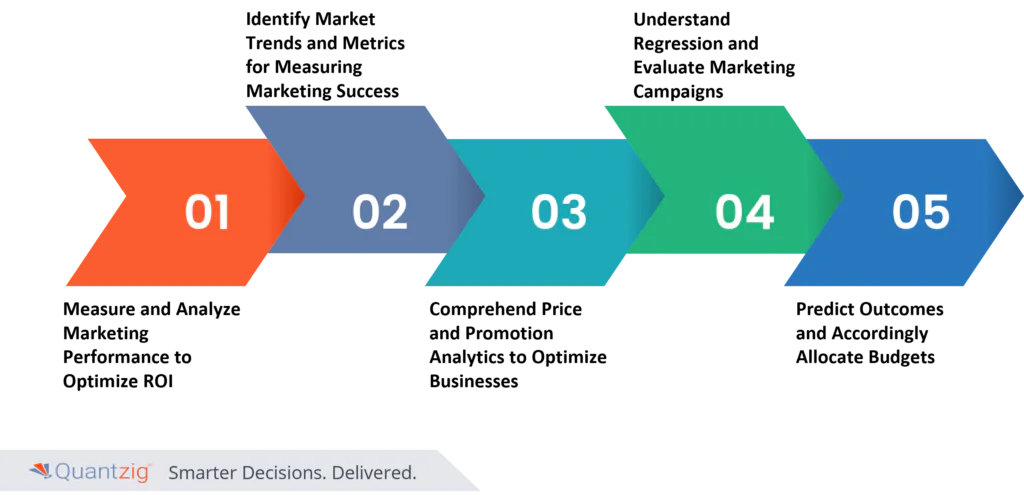Written By: Associate Vice President, Analytics and Data Strategy, Quantzig.
Thriving in the Food & Beverage (F&B) ecosystem isn’t just about offering great products—it’s about harnessing the power of data to fuel strategic decision-making. Quantzig, a leader in advanced marketing analytics, helps F&B companies to uncover actionable insights that drive growth. With evolving consumer preferences and increasing global competition, the ability to make informed, data-backed decisions is critical. Quantzig’s expertise in advanced analytics helps F&B businesses tackle challenges like pricing pressures and revenue stagnation by identifying high-potential segments, optimizing customer reach, and building resilient business models. Discover how leveraging analytics can give your brand a competitive edge
Book a demo to experience the meaningful insights we derive from data through our analytical tools and platform capabilities.
Request a Free DemoTable of Contents
Case Study: Driving Success in the Food & Beverage Industry with Quantzig’s Advanced Analytics Solutions
| Aspect | Details |
|---|---|
| Client Industry | Global Food & Beverage (F&B) company |
| Primary Challenges | Intense competition, global complexity, pricing pressures, and revenue stagnation |
| Key Needs | Targeted market analytics, insights into niche segments, and a robust business model |
| Quantzig’s Solutions | Comprehensive market research, real-time engagement, trend prediction, and an advanced dashboard |
| Dashboard Features | Real-time insights, competitor analysis, and trend forecasting |
| Results Achieved | Improved market positioning, enhanced customer engagement, and revenue growth |
| Impact | Stronger competitive positioning, increased customer loyalty, and sustainable revenue growth |
Challenges Faced by the F&B Client
In a fiercely competitive global Food & Beverage (F&B) landscape, a leading multinational company encountered several challenges that demanded a strategic transformation. Faced with intense competition and stagnant revenue growth, the client recognized the need for a comprehensive market analytics solution to enhance customer targeting and optimize its business model. Quantzig’s expertise was sought to navigate these challenges and unlock new growth opportunities.
Competitive Market and Global Complexity
The global presence of the F&B client complicated its efforts to effectively target potential customers across different markets. With numerous competitors vying for market share, the client struggled to identify niche segments that could be targeted with precision. The competitive intensity necessitated a refined market research approach to differentiate the client’s offerings and enhance customer engagement.
Pricing Pressures and Revenue Stagnation
In addition to the challenges posed by competitors, the client experienced pricing pressures common to the F&B industry, where consumers are highly sensitive to price fluctuations. This, combined with stagnating revenue, highlighted the need for a strategic overhaul of their business model. The client aimed to realign its strategy with market demands and boost profitability in a rapidly evolving industry.
Need for Targeted Market Analytics
To overcome these hurdles, the client required an advanced market analytics study to identify high-potential niche segments. Understanding consumer preferences and behaviors across different regions was key to crafting tailored strategies. A deeper analysis of market dynamics would empower the client to refine its product offerings and optimize customer engagement.
Implementing a Resilient Business Model
The client aspired to create a business model that could withstand market fluctuations and pricing pressures while driving sustained revenue growth. By leveraging insights derived from advanced analytics, the client sought to navigate these challenges and strengthen its competitive positioning in the global F&B landscape.
Quantzig’s Strategic Solutions
To address the client’s challenges, Quantzig deployed a comprehensive suite of advanced analytics solutions designed to deliver actionable insights and drive business transformation.
Go-to-Market Research and Consumer Insights
Quantzig conducted a robust go-to-market evaluation by integrating insights from multiple data sources. This study provided the client with a deep understanding of customer preferences and behaviors across various channels, enabling them to predict market behavior with greater accuracy. The client identified the key features and trends that customers valued, allowing them to tailor product offerings and effectively engage with target segments.
Real-time Customer Engagement and Trend Prediction
Using Quantzig’s advanced analytics tools, the client gained the ability to engage with customers in real-time and anticipate shifts in consumer behavior. By leveraging predictive analytics, the company could respond proactively to market trends, enabling quicker adaptation to changing consumer needs and preferences.
Quantzig’s Food & Beverage Analytics Dashboard
Quantzig introduced its Food & Beverage Analytics Dashboard, a cutting-edge platform that integrated both quantitative and qualitative data to provide a comprehensive view of market dynamics. Key features of the dashboard included:
- Real-time insights into customer preferences, enabling the client to make informed, data-driven decisions.
- Competitor analysis to understand market positioning and differentiate product offerings.
- Trend forecasting, which allowed the client to stay ahead of emerging market shifts and proactively adjust strategies.
The analytics dashboard empowered the client with a holistic perspective on their target markets, fostering improved decision-making and operational agility in an increasingly competitive landscape.
Results and Impact
Through Quantzig’s solutions, the client successfully navigated its challenges and achieved several critical outcomes:
- Enhanced market positioning: By identifying niche segments and tailoring strategies, the client was able to strengthen its foothold in the food and beverage market analysis.
- Increased customer engagement: Real-time insights and predictive analytics enabled the client to engage with consumers more effectively, resulting in improved customer loyalty and retention.
- Revenue growth: The strategic overhaul of the business model, driven by data-driven insights, helped the client overcome pricing pressures and achieve sustainable revenue growth.
Quantzig as the F&B Analytics Partner
By partnering with Quantzig, the F&B client was able to transform challenges into opportunities, using advanced analytics to unlock new avenues for growth. Quantzig’s innovative solutions empowered the client to not only survive but thrive in the competitive F&B sector, reinforcing its position as a global leader.
If you’re looking to optimize your business strategies through advanced analytics, Quantzig can help you gain the insights needed to drive growth and stay ahead in today’s competitive landscape.
Experience the advantages firsthand by testing a customized complimentary pilot designed to address your specific requirements. Pilot studies are non-committal in nature.
Request a Free PilotOverview to Marketing Analytics for Food & Beverage Industry
Marketing analytics in the food and beverage industry leverages data to refine marketing strategies, focusing on metrics like customer acquisition cost and lifetime value. By analyzing sales data, customer surveys, social media, and website interactions, food and beverage market analysis can personalize experiences and optimize campaigns to enhance performance.
Quantzig’s market data analytics solution enables F&B companies to aggregate data from various channels into a unified platform, enhancing marketing analysis, marketing efficiency and strategic resource allocation. This solution also helps firms identify emerging technologies and allocate resources effectively for long-term success.
Future Trends and Innovations in Marketing Analytics for Food & Beverage Industry
Anticipating and embracing future trends and innovations in F&B marketing analytics is paramount for staying ahead of the curve. From predictive forecasting models to AI-driven customer segmentation, the landscape is ripe with opportunities for innovation. Harnessing emerging technologies and methodologies enables businesses to unlock new insights and optimize marketing strategies for enhanced ROI. Moreover, staying abreast of evolving consumer behavior patterns and market dynamics empowers businesses to pivot swiftly and capitalize on emerging opportunities. By fostering a culture of innovation and agility, businesses can future-proof their marketing endeavors and maintain a competitive edge in the dynamic F&B landscape.
Predictive Insights with advanced F&B industry analysis
For Food and Beverage (F&B) industry, leveraging predictive insights through advanced food and beverage market analysis is essential for staying ahead. By utilizing sophisticated data analysis techniques, businesses can enhance their marketing performance, identify key market trends, optimize pricing strategies, evaluate campaign effectiveness, and predict future outcomes. Here’s how: This involves a multifaceted approach that encompasses advertising performance measurement, trend identification, price and promotion, regression analysis, and outcome prediction. Let’s delve into each aspect in detail:
| Key Areas | Insights Provided |
|---|---|
| Measure and Analyze Marketing Performance | Assess the ROI of various promotional channels and strategies using KPIs like acquisition cost and conversion rates. |
| Identify Market Trends and Metrics | Track emerging trends and consumer preferences through metrics such as customer satisfaction and social media engagement. |
| Comprehend Price and Promotion Analytics | Evaluate the impact of pricing and promotions on sales to balance competitive pricing with profitability. |
| Understand Regression and Evaluate Campaigns | Use regression analysis to determine the effectiveness of different marketing variables and channels. |
| Predict Outcomes and Allocate Budgets | Employ predictive analytics to forecast results and allocate budgets towards high-impact initiatives. |
Quantzig’s expertise in advanced analytics provides F&B businesses with the tools needed to excel in a competitive market. Our solutions offer comprehensive insights that drive data-informed decisions, optimize marketing strategies, and enhance overall business performance.
Get started with your complimentary trial today and delve into our platform without any obligations. Explore our wide range of customized, consumption driven analytical solutions services built across the analytical maturity levels.
Start Your Free PilotConclusion
In conclusion, the journey to optimizing customer reach in the F&B industry is an art and a science—an art in understanding consumer nuances and a science in leveraging advanced food and beverage market analysis to transform challenges into opportunities. With every strategic insight gleaned, the path to sustained success in customer-centric F&B markets becomes clearer, ensuring companies not only meet but exceed the expectations of an ever-discerning consumer base.





